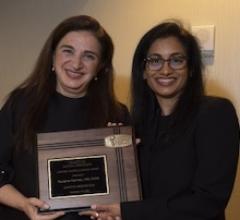
November 18, 2021 — A novel software algorithm compatible with a wide range of smartwatches and fitness trackers detected irregular heart rhythms and accurately identified undiagnosed atrial fibrillation 98% of the time, according to the late-breaking FitBit Heart study presented at the American Heart Association’s Scientific Sessions 2021.
Many smartwatches and fitness trackers can detect the wearer’s pulse rate using light sensors. Researchers developed a novel software algorithm to analyze pulse rate signals and infer the presence of atrial fibrillation (AFib) on one brand of wearables. The algorithm operates during periods of inactivity and uses a process that examines continuous and overlapping episodes of pulse information from the wearable device to analyze for an irregular heart rhythm. The algorithm requires at least 30 minutes of sensing irregular heart rhythms to indicate the presence of possible atrial fibrillation.
“Undiagnosed atrial fibrillation can lead to strokes, and early detection of atrial fibrillation may allow doctors to prescribe medications that are effective at preventing strokes,” said Steven A. Lubitz, M.D., M.P.H., associate professor of medicine at Harvard Medical School and cardiologist at the Massachusetts General Hospital in Boston.
In this study, conducted from May through October 2020, investigators from Massachusetts General Hospital and fitness wearable manufacturer Fitbit remotely enrolled more than 455,000 adult smartwatch or fitness tracker users in the U.S. None of the study participants had a self-reported prior diagnosis of atrial fibrillation. The average age of the participants was 47 years; 71% were female; and 73% were white. The data from their devices were analyzed using the novel software algorithm.
Participants who had an irregular heart rhythm detected by the software algorithm were notified and invited to schedule a visit with a telehealth professional. After meeting with the telehealth doctor, participants received a one-week electrocardiogram (ECG) patch monitor to wear along with the smartwatch or fitness tracker.
The analysis found that the novel software algorithm was able to successfully detect atrial fibrillation, and the findings were consistent across age groups. Specifically:
- Irregular heart rhythm detection occurred in 1% of individuals overall and 4% of adults older than 65 years.
- Among individuals who received notification of an irregular heart rhythm, 32% had atrial fibrillation detected on a subsequent ECG patch monitor.
- The ECG patch confirmed atrial fibrillation in 98% of individuals who had another irregular heart rhythm detection while wearing the ECG patch monitor.
- For participants over 65 years old, a subgroup at elevated risk for stroke caused by atrial fibrillation, the algorithm corresponded to concurrent AFib 97% of the time.
“These results show that wearables have the ability to identify undiagnosed atrial fibrillation with high reliability,” Lubitz said. “Since so many consumers use wearables, it is possible that algorithms such as the one we studied could be applied widely to help identify undiagnosed atrial fibrillation, allowing patients to obtain care before devastating complications such as a disabling stroke may occur.”
He added, “Most of the episodes of undiagnosed atrial fibrillation detected occurred during sleep, and we suspect that these episodes were asymptomatic. Since the algorithm is most active when wearers are physically inactive, the wearable should be worn during sleep for the greatest benefits.”
The algorithm is currently being reviewed by the FDA for clearance and widespread use. The study did not test whether screening for atrial fibrillation leads to a reduction in strokes, which Lubitz notes is an opportunity for future research.
Co-authors are Anthony Faranesh, B.S.; Caitlin Selvaggi; Steven Atlas, M.D.; David D. McManus, M.D.; Daniel E. Singer, M.D.; Sherry Pagoto, Ph.D.; Alexandros Pantelopoulos, Ph.D. and Andrea Foulkes, Sc.D. Authors’ disclosures are listed in the abstract.
The study was funded by Fitbit.


 November 14, 2025
November 14, 2025 









